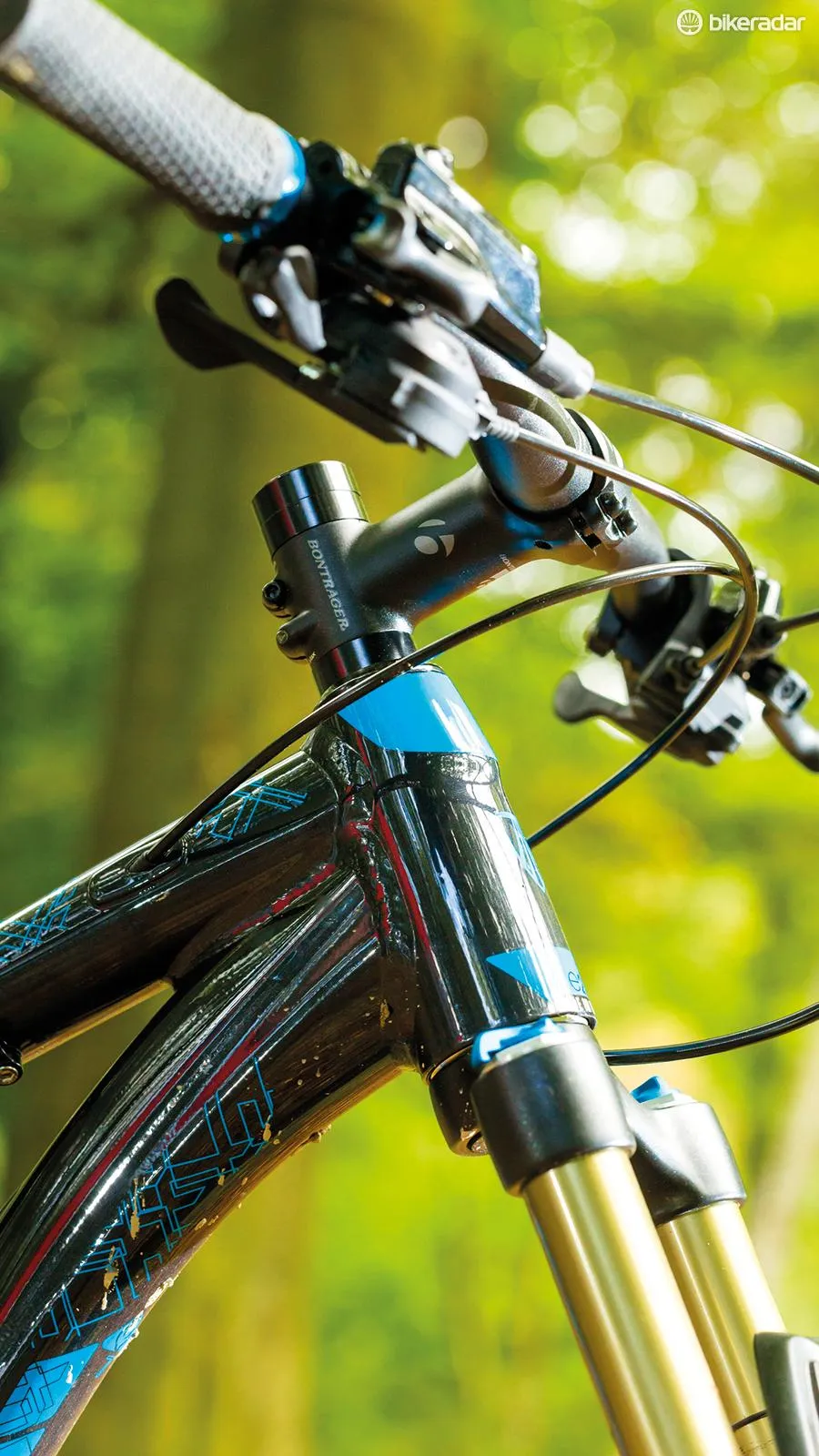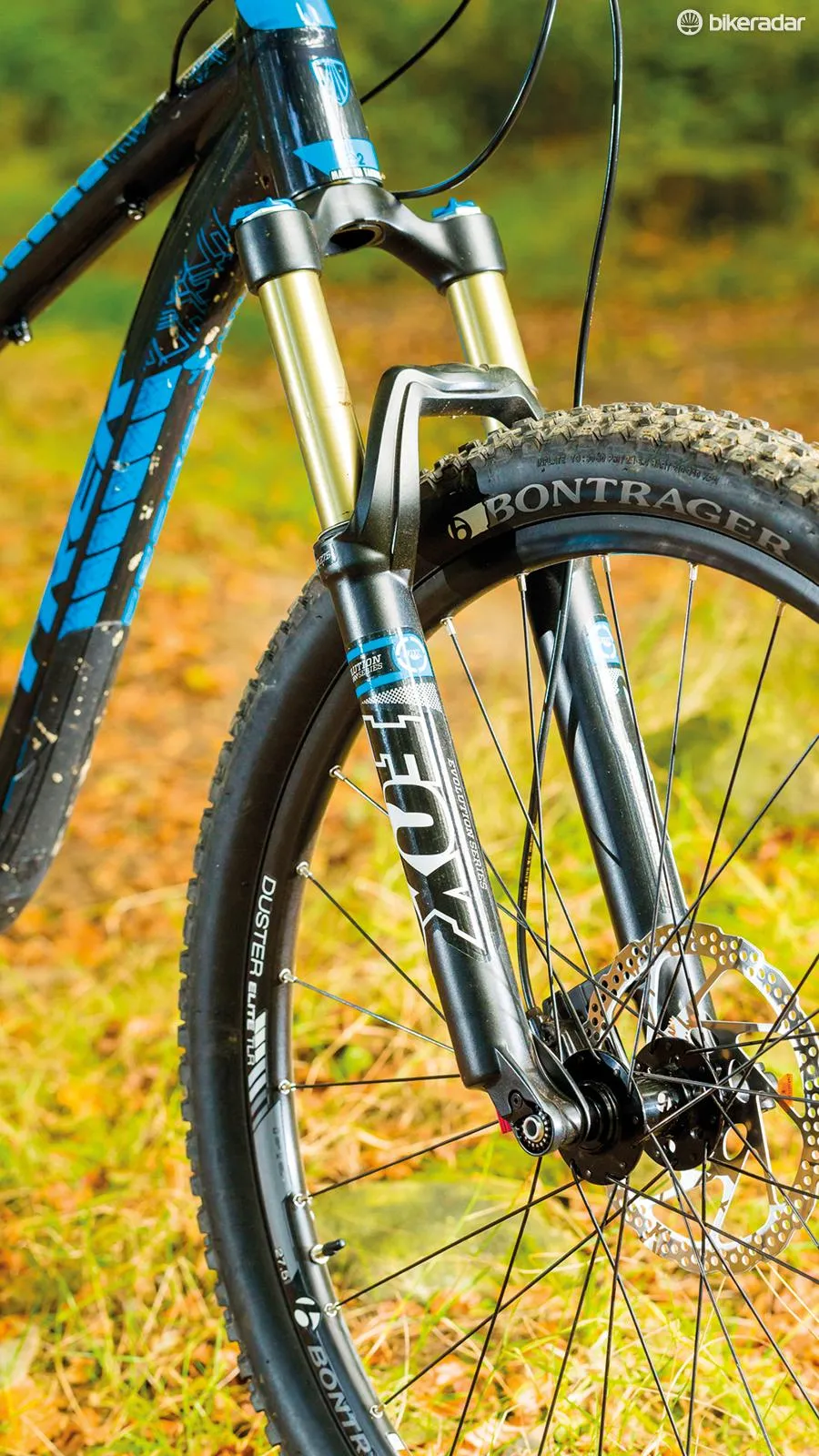Trek’s understated yet moreish Fuel EX 7 is rather like a trail bike equivalent to corn flakes or vanilla ice cream – plain-seeming compared with some of the exotic alternatives that are now available, but extremely tasty once you get reacquainted.
Ride and handling: balanced-handling 650b update is an engaging package
The various generations of Fuel have been Trek’s 120-130mm travel do-it-all stalwarts since the days when V brakes were standard fit. They’ve seen a host of innovations in the shape of E2 tapered headsets, tubeless ready wheels and tyres, Full Floater shocks squeezed between upper linkage and chainstay tips rather than the mainframe, DRCV dual chamber shocks and ABP wheel axle concentric rear pivots, which became the multi-axle ABP convert. Trek was also the first company to provide clip-on plastic sag guides for easy shock set up.
Affordable alloy or high performance carbon frames covered a full range of prices and for years it was a go-to bike for a really good time on whatever trail was stretching out in front of you. So it was no surprise that we took an alloy EX to North Wales for our Trail Bike of the Year test a couple of years ago.

Cockpit choices aren’t radical but they are effective
Within a couple of corners it was clear that what was needed wasn’t more evolution but a real revolution. Its little 26in wheels clattered and skipped across the rocks of Snowdonia, spilling speed and confidence all over the place as they went. The alloy frame felt heavy, there was no swagger in its steering and it was obviously lacking the tailwind effect of bigger wheels. Even though we doggedly hung onto it as a long termer to try and tweak it better we never found the love.
Riding the top EX 9 alloy bike this summer it was clear the Fuel’s switch to 650b wheels (a 29er version is also available) has made a massive difference, and the lower spec, non Re:Aktiv EX 7 model proves the admission price for all-round get on and go fun is impressively affordable.
As with any good bike fit is crucial – and while Trek’s virtual sizing is a bit of a brain bend, the long top tubes and shorter seat tubes it generally delivers work well. Cockpit dimensions and geometry mean steering is stable enough when you need back up in a boulder fight or scree slide, but not so needy it demands constant correction when you’re climbing or cruising along skinny sheeptrack.

The Fuel's chunky weight means it takes a while to get up to speed, but once you're there it holds momentum with the best of them
Tracking of the Fox 32 fork is a bit vague at times, but the sensible rather than radical steering angles mean you’re never tricked into thinking there’s more traction or control than there really is. It’s the same story of holistic balance with the bars and stem. You could fit wider bars and a shorter stem but then you’d probably need the grippier XR4 tyre up front rather than the faster XR3 here, and you’d definitely notice the fork twist more. If that’s the sort of ride you want you’d probably be better off with the beefier, slacker, 140mm travel Remedy 7.
Our only significant criticism of the 7 is its weight, which makes acceleration steady rather than sudden compared with some of its peers. It generally hides its mass very well in the overall ride, to the point where it’s a surprise when you have to heave its heft over a gate. Once you’ve got it up to speed it holds onto it with a dogged amount of pride whether you’re half-wheeling mates up a fire road or battling up one of those climbs that would be better as a descent. The XR3 tyres underline overall performance with decent drag-free grip and they’ll feel and roll even better if you pop in the supplied tubeless strips and valves and switch tubes for sealant.
Frame and equipment: versatile setup that's ready for anything
Fox’s Evolution series dampers are far more consistent than they were last year so there are no nasty surprises in the fork stroke and setup couldn’t be simpler. Type your ready to ride weight into the online calculator on Trek’s website and it’ll give you starting point pressure and rebound settings to get you in the ballpark before you even get on the bike.

A Fox rear shock gets DRCV technology for a deep and plush feel
Once you’ve checked the sag with the provided clip-on marker, the rear suspension is equally unobtrusive. While it’s not as crisp and on point as the Formula One technology-inspired Re:Aktiv dampers on Fuel EXes, the split chamber DRCV shock is still strong under power and the automatic opening second shock chamber means it’ll take a fair wallop or drop without bucking you offline. The Descend, Trail and Climb modes are different enough to be worthwhile and it’s pedal, brake and chainring neutral enough that you can concentrate totally on the trail and not worry about how to make the bike work with each bit.
The same ready-for-anything attitude adds useful versatility to the rest of the frame. There’s a replaceable plastic belly guard because alloy bikes are just as likely to take a rock in the guts as a carbon frame. The bottom bracket has chainguide mounts in case you ever want to fit a chain device. There’s no direct compression shock load on the mainframe so the Alpha Platinum tubes can be made thinner and lighter. The magnesium EVO rocker link is forged in a single piece for maximum strength and stiffness compared to a welded or bolted multi-piece link. Internal routing is neat and it’s plumbed for an internally routed seatpost hose, which is great because a dropper post is the only thing that’s obviously missing when things get techy.
Ultimately this isn't the most radical ride and it’s heavy, but if you want a really well balanced, consistently friendly, get on and go trail bike then Trek’s entry-level EX 7 should be on your shortlist.









